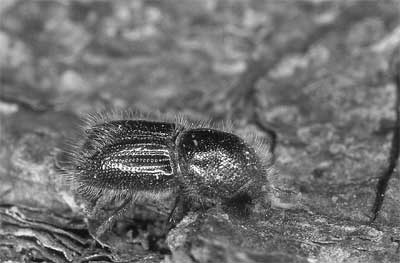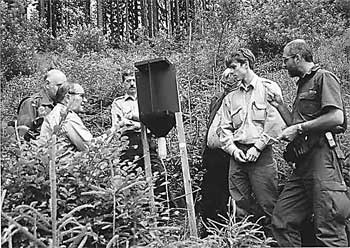


J. Novotný
Július Novotný is Head of the Department of Forest Protection and Game Managemant of the Forest Research Institute at Zvolen, Slovakia. He is also an Asssociate Professor in the Forestry Faculty, Technical University Zvolen, where he teaches forest protection and integrated pest management.
A participatory forest protection strategy for spruce stands in the Kysuce region of northwestern Slovakia promotes the use of ecologically friendly methods for protection of spruce stands against insect pests and fungal diseases.
Spruce (Picea abies) forests contribute significantly to the economy and ecology of Slovakia. In the Kysuce region in the northwestern part of the country, which has 59 percent forest cover, half of the forest area is covered by spruce, which is native to Slovakia although most of the forests in the region are planted. Commercial forest stands account for 76 percent of the region’s forests, special-purpose forests 20 percent and protected forests 4 percent.
Spruce bark beetles and fungus diseases, individually or collectively, threaten the vitality of the region’s spruce forest ecosystems on a very large scale, causing the death of many trees and loss of timber. The main beetle species include Ips typographus, Pityogenes chalcographus, Ips duplicatus, Ips amitinus and Polygraphus polygraphus; the main fungus species are Armillaria ostoyae, Heterobasidion annosum, Stereum sanguinolentum and tracheomycosis causing Ophiostoma sp., Grafium sp. and Verticillium sp. Most of the areas infested by bark beetles and fungal disease are spruce monocultures or mixed stands that are more than 75 percent spruce.
The environmental and economic impact of insects and diseases has been considerable. Biotic and abiotic damage during the past five years resulted in 427 000 m3 of unplanned fellings – representing 80 percent of annual felling. Added to this loss of valuable timber are environmental impacts including degradation of forest ecosystems and protected areas. With trees failing to mature, the areas of young stands (areas of natural and planted regeneration) are relatively large, and the forest ecosystem cannot fulfil all the functions of mature forest stands; for example, the conditions for wildlife are less suitable. In water catchment areas, the forest degradation has resulted in lowering of water quality as a result of soil erosion. Poor management of infested trees – i.e. the failure to remove them from forest stands in time – has also caused environmental degradation.
Addressing the problem is a challenge to forest owners and managers and requires a great commitment of time and financial resources. In 1998 the government and forest owners spent the equivalent of about US$405 000 on forest protection measures. The development and adoption of a comprehensive system of pest control measures by all forest owners based on an integrated pest management (IPM) strategy is among the region’s main forestry priorities. IPM emphasizes prevention as the main priority, and integrates ecologically friendly measures such as biological control rather than chemical inputs.
Private individuals, groups, municipalities, towns and churches own 79 percent of the region’s forests, and the Slovak Government 21 percent. The average size of non-State forest holdings is small, the maximum being 100 ha. Because of the fragmented ownership of forests in Kysuce, an area-wide approach to integrated pest management and the participation of communities are necessary to the success of any IPM strategy.
The FAO technical cooperation project “Protection of Spruce Stands”, launched in 2001 to assist with IPM activities in Kysuce, catalysed the involvement of all forestry groups in the region in integrated pest management. Local or village-based forest owners, managers or groups (the “local community”), including local associations of individual, private or group forest owners, worked in partnership with the project team.
The project team instructed the local community in the methodology for monitoring the economically important pests in the region, covering:
The pilot activities in which collaboration was developed between the project team and the community of forest owners included the use of synthetic pheromone traps for mass trapping and monitoring of pest population densities. The community members were given pheromone traps and lures free of charge. The interest in IPM was so high that community members conducted their own complementary field experiments in parallel with project activities, using pooled resources. The FAO project team provided forest owners with the methodology and helped to establish a pheromone trap network in the project area. The community collected the data and provided the project team with information about local conditions.
The results were positive. The use of a uniform system of bark beetle monitoring and mass pest trapping by the whole community guaranteed area-wide control. During 2001, more than 700 000 individuals of I. typographus (second generation) were collected and more than 14 million of P. chalcographus. In 2002, more than 1.7 million I. typographus and more than 23.8 million P. chalcographus beetles were collected in the traps; these results included two generations. Tree infestation and tree damage were reduced 70 percent compared with the situation before the project began.
A programme for training forest owners and forest managers in IPM was established and applied in another community in the Kysuce region. The most accomplished individuals from the private and State forest sector became trainers. Several training publications were produced:
Since 2003, when the FAO project was completed, all activities (technical and financial) have been led and carried out by the local forestry community with the help of the Forest Research Institute at Zvolen and the office of the local forestry authority.
It is planned to extend the training programme to other regions of Slovakia and neighbouring countries with similar pest problems in spruce stands (the Czech Republic, Poland). The aim is to establish optimum conditions to enable communities – small farmers, large private forest owners and State forest enterprises – to coordinate integrated pest management and an area-wide forest protection approach.
Ips typographus – the main pest of spruce stands in the Kysuce region of Slovakia |
 |
J. NOVOTNÝ |
The project team explains the concept and strategy of community involvement in IPM to private and State forest owners and companies |
 |
J. NOVOTNÝ |
Instruction in how to use pheromone traps and lures for bark beetle monitoring and mass trapping |
 |
J. NOVOTNÝ |